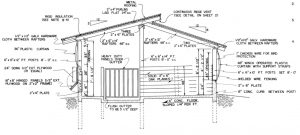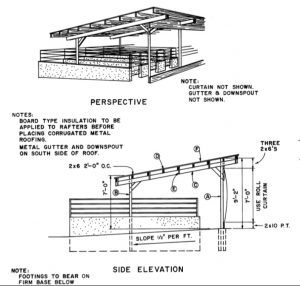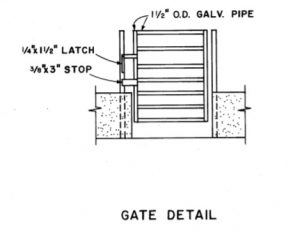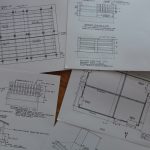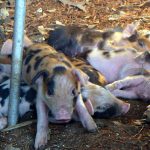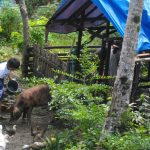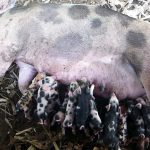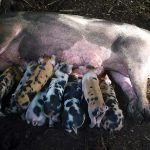We have been keeping pigs for almost 9 years now and our accommodation for pigs, in a tropical backyard setting, have changed over the years. Here’s how things developed, plus an outlook for the future.
The Tethered Pig
As often practised by people in our village with very limited space and resources, we kept pigs on a leash and tied them to a tree during the daytime and then tied them under the house at night. If we had 2 pigs we had to keep them a distance from each other. Otherwise their leash would get tangled up and they may get hurt. Our first fatteners and a gilt were tethered pigs. When our gilt was about to farrow, we built a little pen for her. The pigs were fed in modified large plastic containers.
In the video below, the gilt Miss Piggy is tethered next to the goat house under a tree.
The video below shows a conventional concrete pigpen commonly found in our village. A boar and 5 sows are kept in individual pens.
The Penned Pig
We started with a small pen, about 8 square meters. It was made of strong bamboo and had nipa palm fronds for roofing. The flooring was just soil with some sawdust and rice hull mixed in. We kept a fattener in this pen. Later, we enlarged the pen to about 20 square meters. We raised our first boar, kept two gilts, had a sow farrow in this larger pen. We also kept 1-2 fatteners at a time here.
In the video below, Bootleg, who had just undergone hernia repair surgery, plays ball in a pen made of bamboo and wood.
In the video below, sow Number 3 farrowed for the first time, to 4 piglets in this bamboo pen. The piglets are 2 weeks old in this video. We installed a creep rail with warming lamp which the piglets never used! In the latter part of the video, Number 3 is shown eating from the wooden trough. After many months of use, water leaks out of the trough and floods that area.
Later, we built two more pens of about the same size, so that we could rotate the pigs and allow the empty pens to fallow and get cleaned up. The two new pens were made of coconut and some scrap lumber, bamboo, nipa and tarpaulin roofing. The pigs were fed in large plastic container or modified rubber tires. Later, we decided to build troughs out of mahogany planks. The troughs can be filled with food and water from outside the pens. The pigs couldn’t turn over the troughs so the food and water didn’t get spilled. This made feeding much easier. We tried installing pig drinkers but as the pigs got bigger they destroyed those things.
In the video below, five new piglets enjoy the soil and grass in a large pen made of coconut lumber, some bamboo and scrap pieces of wood. In less than a week, all that grass is gone.
In the video below, 3-day old piglets play fight in the same pen shown above. The piglets were born in this pen.
Over 2 years, we used these pens. We kept a boar, 3 sows, a few fatteners in these pens. We had 4 farrows in these pens. Over the years, these pens required a lot of maintenance and emergency repairs. The wood rotted and pigs escaped several times. Ducks went into the pens and got eaten by pigs. The roof rotted and leaked when it rained and flooded the pens with mud. The pigs loved the mud but when there was too much mud, there was no dry place for them to sleep in. We desperately needed better pens.
In the video below, 2 young boars are fed on a tire cut in half. When it rained and the pen became very muddy, it became impossible to keep feeding the pigs this way. We got stuck in the mud!
The Better Penned Pig
At the moment, our pigs are in their new accommodation built 14 months ago. The designs of the pens were inspired by the following technical illustrations. These illustrations are from Swine Plans published by the University of Tennessee, Institute of Agriculture. We modified the designs to suit our location, climate and needs.
The pens have half meter walls made of concrete and over that are fences made of strong mahogany wood planks. The fences have gaps for good ventilation and sun exposure. The fencing for the boar pen is higher (about 4 feet high) than those for the sows (about 3 feet high) because the boar is much bigger and can jump out of the pen. These pens are a spacious 22-25 square meters. The farrowing pen has a creep rail and an escape hatch. The escape hatch allows the piglets to go out into the garden. The farrowing pen has LED lighting and an extra socket for a heat lamp for piglets born in the cool season.
All the pens have concrete troughs built along the side wall of the pen. The troughs can be filled with food and water from outside the pens.
In the video below, sow Auntie Brownie is with her piglets in the maternity pen. The trough and creep rail is visible, as well as the escape hatch behind the creep rail.
Two of the pens are right next to each other with a gate in between. The boar stays in one pen and the sow is placed in the other. This boar-sow contact allows the sow to go in heat and makes it easier for us to detect when the sow is in heat. If it is time to mate the pigs, we just open the gate in the middle (see video below).
The roofs of these pens are made of galvanised iron sheets, built at a height of 9-12 feet for ventilation and sun. Unfortunately, the roofing material are thin and may need to be replaced in a couple of years. The gates of the pens are made of galvanised iron pipes which we painted over. The floors of the pens are soil mixed with saw dust and many other natural materials such as dry banana leaves and coconut leaves. We have also sprayed the floor of the pens with lactic acid bacteria solution (LABS) and added some IMO (indigenous microorganisms).
Improvements
We need to keep the sow more comfortable in the farrowing pen during the hot summer months. We plan to put an electric fan in the farrowing pen and direct it towards the creep rail. We hope this would encourage the sow to farrow next to the creep rail which will protect the piglets better from crushing.
We need to fence an area of the garden around the farrowing pen so that when the piglets are out in the garden, they will not wander away outside of the property where they could be in danger (particularly by dogs). The fenced area needs to be large enough for the piglets to run around in and should at the same time keep the piglets away from sections of the garden where we don’t want them to go. The fences should be short (2 feet or less), strong but not imposing and should be made of material where vine plants can grow over. At the same time, the fences should not get in the way when we rotate sows from one pen to another.
Coconuts and mahogany pods fall on the roof of the pens and if this persist, the roofs will be destroyed. We plan to cut these trees. This will allow the fruit trees, native trees and shrubs already growing in the area to flourish and provide shade and forage for the animals.
We would also like edible fruiting vines to grow up the pigpens and over the roof. This will provide shade and food for humans and animals. We are working to have more vegetation grow around the pigpens.
We will also have to continue using IMOs and LABS in our pigpens. We think that these, plus sufficient ventilation and sunlight, destroy pathogens in the pens. When we fallow a pen, that’s also when we harvest good organic compost which enrich the gardens where soil is very poorly and rocky.
Basic Principle of Natural Environment for Housing Pigs
Below is a good video that explains the design principle of housing for Natural Farmed pigs. We did not implement this design completely in our pigpens but we do our best to keep the principle of re-creating something as close as possible to a natural forest environment, the natural home for the domestic pigs’ ancestor, the wild boar.
Here is another interesting video (below, in 3 parts) that explains the importance of environment, welfare and public health in pig farming. Several examples of sustainable and profitable systems shown may be useful for those seeking better ways of raising pigs.
Stocking Densities for Pigs
There are several recommendations based on welfare regulations on stocking densities for pigs. Most of the figures are based on accommodation in temperate or non-tropical settings. We believe that because of high temperatures and humidity in the tropics, the minimum space required for pigs should be larger than those recommended in the link below.
Refer to The Garth Pig Stockmanship Standards on Stocking Densities.
We will post updates once we have implemented the improvements planned for next year. If you have any questions about our pig accommodations, don’t hesitate to leave a comment and we’ll do our best to reply.

